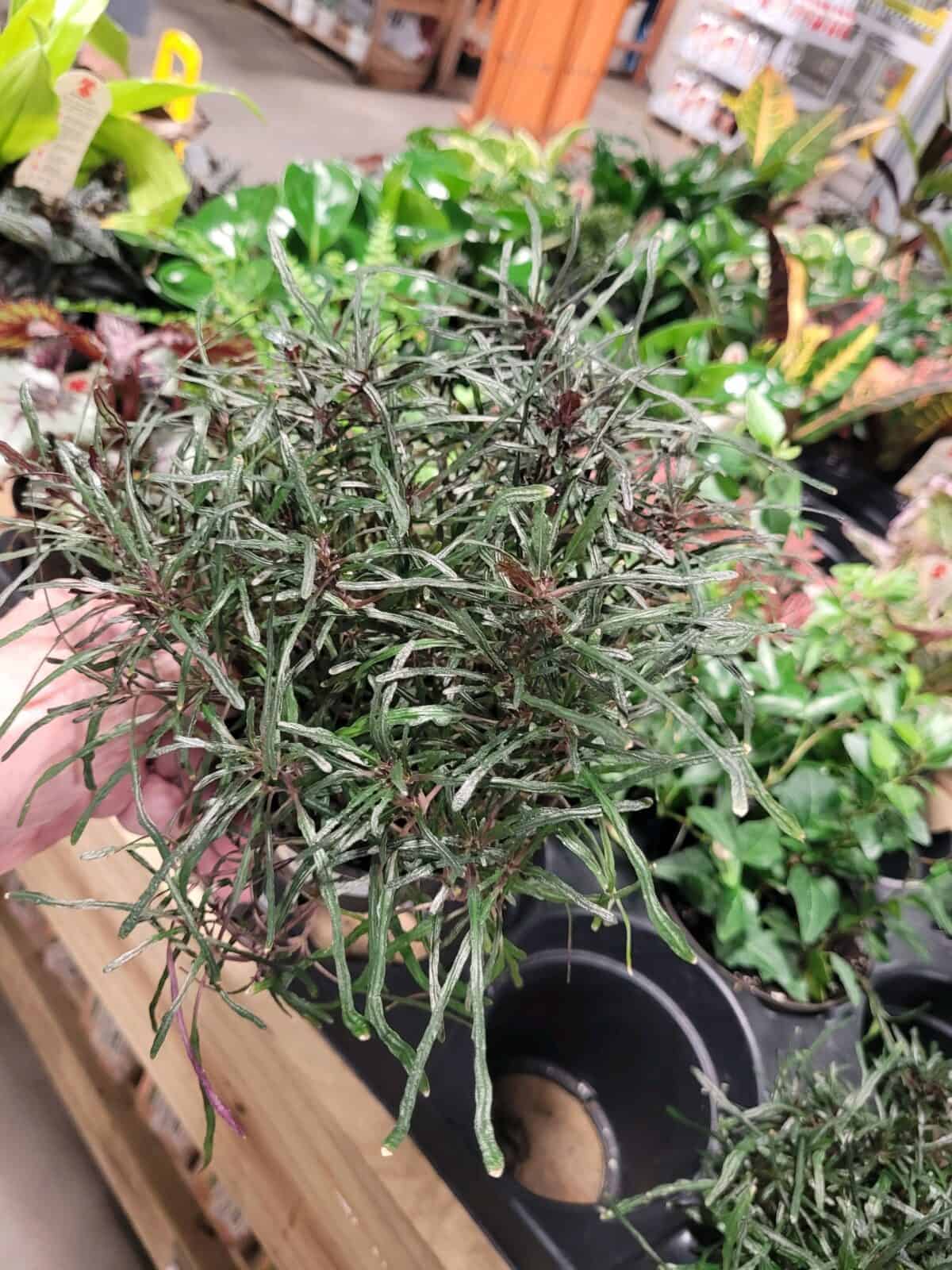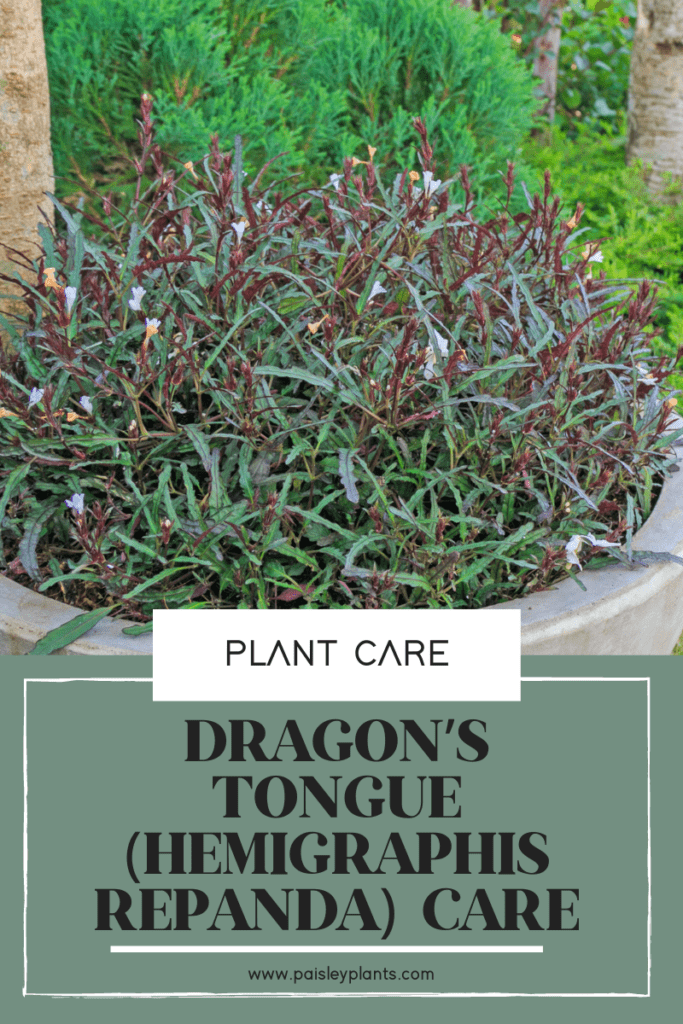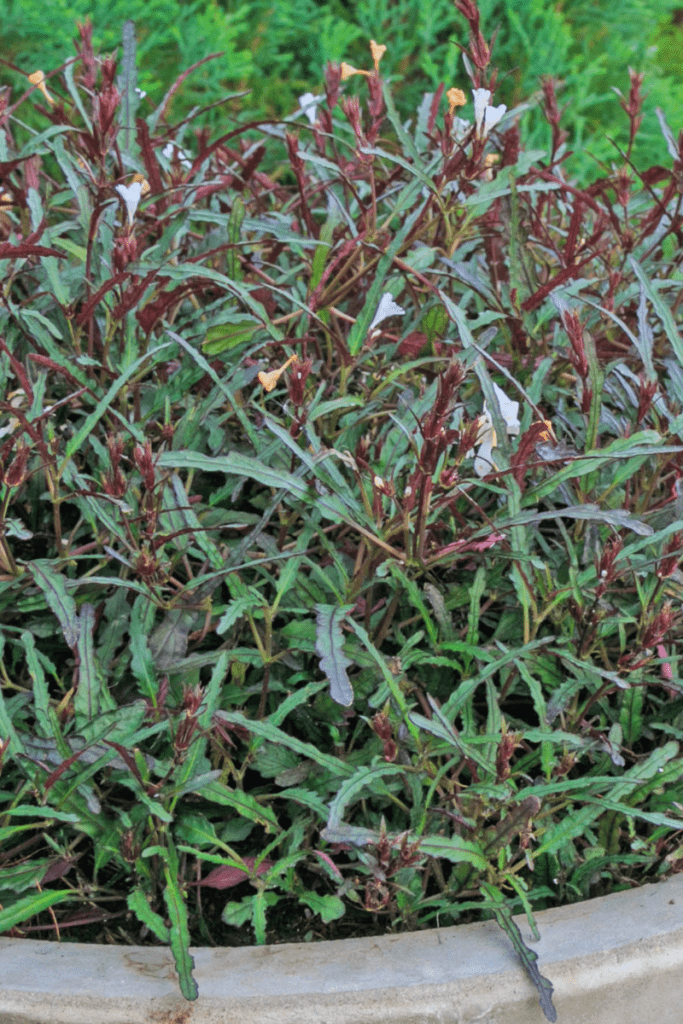How many times have you seen a dragon’s tongue in a movie or in a book? They are usually wispy looking and sometimes even have a split end on them. Well, the plant called Dragon’s Tongue (Hemigraphis Repanda) has kind of that same look to it. It has wispy purple and green leaves that somewhat resemble a dragon’s tongue!
They do tend to have wavy edges to them, which is part of the origin of their name also. The scientific name is Hemigraphis Repanda. Hemi means “half” and graphis means “stylus” or “paintbrush.” Repanda refers to the wavy edges of the leaves on this particular plant.

The most common name you will hear this plant being called is Dragon’s Breath. However, it has a few others including Waffle Plant (due to the texture of the leaves), Narrow Leaf Hemigraphis and Ruellia Repanda.
These plants are native to India and Malaysia. They can be grown as indoor or outdoor plants or are even used in aquariums! In South Florida, they are considered perennials where the conditions are such that they can be grown year round.
They are used as a beautiful ground cover in shaded areas. They can grow 6 inches tall and 12 inches wide and make for a nice indoor plant also. Their texture makes for a lovely addition to any type of planting you decide to make.
These plants produce beautiful small white flowers with five petals when grown in the ideal conditions. They bloom in the early spring or summer and have a delicate scent that attracts pollinators.
Table of Contents
Toxicity
Dragon’s Tongue plants are considered to be toxic to humans and animals. So, you should take care where you place this plant. If you have questions about which plants are toxic to your animals, the ASPCA has a full list of toxic and non-toxic plants on their website, which is a very helpful resource.
Dragon’s Tongue Care Tips

This post includes affiliate links.
Watering
The Dragon’s Tongue plant is not particularly drought tolerant, so it needs to be watered when the soil is dry about an inch into the soil. You will need to determine the best watering routine for your plant which will depend upon where you plant is placed and the light source it has.
You can check the moisture level in the soil by sticking your finger into the top layers of the soil to see if it is dry or not.
It should not be allowed to sit in overly wet soil, however. Overwatering is the biggest problem a Dragon’s Tongue plant will encounter.
This will lead to root rot and if you don’t keep on top of it, your plant will die! Always monitor the soil moisture level to ensure it is not too wet or soggy.
Light
Bright filtered light will encourage the best growth for your Dragon’s Tongue plant. When in an outdoor setting, indirect partial shade is the best place to grow this exquisite ground cover.
Low light conditions will hinder growth and the leaves will turn a faded green color with no purple underside. If you have your plant in too much light, however, it may burn the plant. The best light levels determine how well your plant grows.
Soil
Dragon’s Tongue plants prefer evenly moist, porous and well-drained soil to grow well. You can use a regular commercial potting soil or you can mix your own well-draining soil.
Whichever you prefer, just be sure to not let your plant sit in water. Keep the soil evenly moist and you should be good!
Fertilizer

Your Dragon’s Tongue won’t require fertilizing in the dormant months, which are during the fall and winter. You should fertilize it when it is blooming, however. This would be in the late spring or early summer.
Use a diluted liquid fertilizer which you can purchase online or at your local garden center. You can follow the directions on the package to be sure you don’t use too much.
When growing outdoors, the soil should provide all the fertilizing the plant needs via rainfall.
Temperature and Humidity
These plants enjoy being in warm temperatures, so if you have a nice warm spot with indirect sunlight, that would be the place to put your plant. The temperatures should not go below 40 degrees F.
If you can, place your plant outdoors for the warmer months, that would be ideal. However, average room temperatures should be just fine for these plants.
They don’t require any special maintenance as far as humidity goes. The normal humidity conditions in most homes will be fine for your Dragon’s Tongue plant.
Although these plants are sometimes sold as aquarium plants, they cannot survive under water.
Pests and Diseases
The Dragon’s Tongue is susceptible to a few insects including whiteflies, bean weevils, and Mexican bean beetles. If you find that your plant is infested with these pests, a good insecticide will help keep these pests away.
You should spray the pests off with water, then treat the plant with insecticidal soap for up to 3-4 weeks until the pests are gone.
They can also develop white spots if they are not watered enough. If this happens, you need to be sure to water the plant on a more regular basis to avoid the white spots from developing again. The leaves may also become thinner during a time when you aren’t watering the plant sufficiently.
Pruning
Be sure to take off any leaves that are brown or yellow to encourage healthy growth of your Dragon’s Tongue. If you keep your plant in the right conditions, it should be healthy and not need much pruning, for the most part.
Repotting
When you repot your Dragon’s Tongue, use a pot that is about one to two inches larger than the previous pot. You need to be sure it has good drainage holes in the bottom of the pot, so the soil doesn’t remain too wet after watering.
One thing I have found to work well to keep the soil in the bottom of the pot from seeping out of the drainage holes, is to place about 3 – 4 paper coffee filters in the bottom of the pot before I put the soil in.
They will eventually break down, but also will contain the excess soil and it will not just run out the bottom of the pot. I use the coffee filters all the time when I repot plants and they have been a great way to contain the soil inside the pot.
Propagating your Dragon’s Tongue Plant
There are two ways to propagate a Dragon’s Tongue plant:
- Root division
- Stem Cuttings
Root Division
- If you choose to divide your plant through root divisions, you can remove the entire plant from its pot and divide it into sections. Take each section, remove the old dirt, and place each section into the new soil in a new pot.
- Don’t overwater the new plants, but keep them slightly moist. They should take hold and start growing approximately one to two weeks after you repot them. This is probably the easiest way to propagate this type of plant.
Cuttings
- Take a sterile scissor and remove several cuttings from your plant. Be sure to have enough of a stem portion that it can be placed into the new soil at least a few inches. Remove any bottom leaves to allow for a good portion of stem to plant in the soil.
- If you have rooting hormone powder, I would use it. This will give your plant a boost as far as growing quicker. Dip the end of the cutting into the rooting hormone powder and stick it directly into the new soil.
- Mist the cuttings thoroughly and don’t overwater these at least for a week. When you do start watering the cuttings, be sure you don’t overwater them. You will know they took hold once you can tug on them and they don’t pull out of the soil.
Common Problems
The most common problem for a Dragon’s Tongue plant is overwatering. This is such an easy problem to solve, that it doesn’t really even need to be addressed. Just don’t overwater your plant! It’s that simple!
FAQs
The leave of your Dragon’s Tongue is fading due to insufficient light. Simply move your plant into a place where there is bright, indirect sunlight for at least six hours a day. This will help your plant get back to the rich, green color it normally has!
No, this plant will only survive outdoors in climates that do not have temperatures below 40 degrees F. You can place these plants outdoors in pots over the summer months, but should bring them inside once the temps start dropping down below 45 degrees or so to ensure they don’t die.
This will be determined by the conditions (temperature, light, humidity) where you keep your plant. The best way to determine when to water your plant is to stick your finger into the soil about an inch. If it is dry, you should water it. This will usually give you a pretty good idea of when your plant is ready to have another drink!
In Conclusion
Dragon’s Tongue will reach its full potential when grown outdoors, where it gets plenty of bright, indirect light and can grow and spread freely on the ground as a groundcover.
However, it does do well as a houseplant and with its wavy, fringy look, it is a neat way to add some interest to your houseplants. It won’t grow real large, so can be set alongside other plants for added texture to a grouping of plants on a table or shelf.
As mentioned above, this plant is often sold as an aquatic plant, but is not a true aquatic plant and can only live submerged for extended periods of time before melting away. It does like to be grown in high humidity conditions such as in a terrarium, though, so this might be a good option if you choose to use it in this type of planting. Keep on growing!
